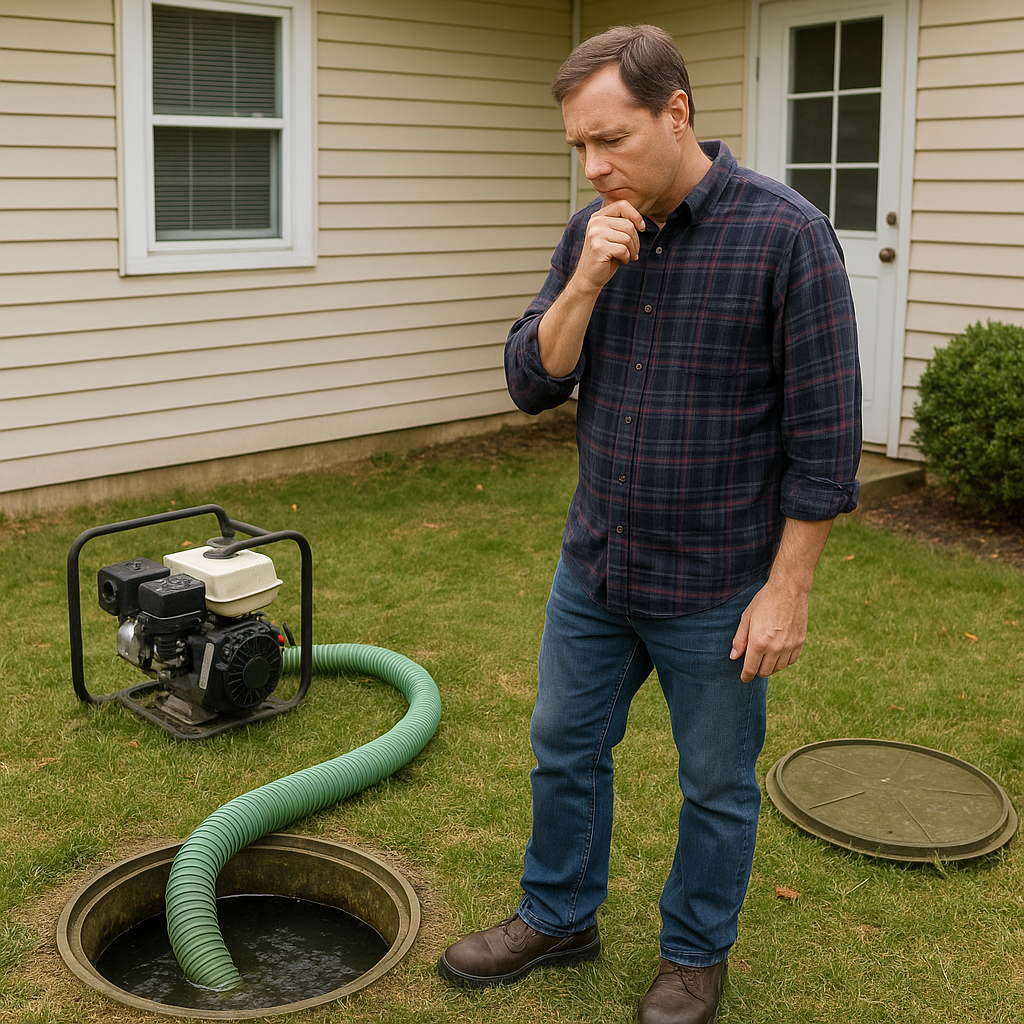Ever thought about saving a few bucks by handling DIY septic maintenance yourself? Many homeowners consider tackling this task alone to cut costs, but it comes with serious septic tank pumping risks. At first glance, it seems easy: rent a portable septic pump, open the tank, and remove the waste. However, the reality is far more complicated and dangerous than most people realize. Septic tank safety precautions exist to prevent both personal injury and property damage. One small mistake can lead to costly repairs or even pose health hazards from harmful bacteria and gases.
Your septic tank plays a central role in household wastewater management. Skipping professional maintenance or underestimating the task may increase the DIY septic tank cost over time due to mistakes that damage the system. While online tutorials make it look simple, actual tank pump outs involve detailed steps and specialized septic pumping tools that most homeowners do not have. Understanding the risks, such as septic system DIY failures, and weighing them against potential cost savings is critical. Choosing between professional help and attempting a DIY approach requires careful thought about your homeowner septic responsibilities and the septic system lifespan.
This article explores what a proper pump out entails, the hazards of DIY work, and septic service alternatives. For guidance on how often your system should be pumped, check out our septic tank pump out frequency guide. By the end, you’ll have a clear understanding of whether rolling up your sleeves is worth it or if leaving the task to professionals is a wiser choice.
The Evolution of Septic Tank Maintenance
Septic systems were once considered simple, low-maintenance solutions. Many homeowners assumed that after installation, their tanks would function indefinitely without attention. However, experience has shown that septic systems require regular care, including observing a septic maintenance schedule, performing septic system cleaning methods, and conducting routine checks to prevent septic tank overflow causes. Septic sludge removal is essential to avoid clogs and foul odors, as solids and oils build up over time. Tanks left unattended can lead to expensive repairs, damage to the drain field, and environmental hazards.
A septic tank is an underground container designed to separate and break down wastewater. Solids settle as sludge, oils float as scum, and liquids pass into the drain field. Ignoring maintenance is like letting your gutters overflow; eventually, a small problem can become a costly, messy disaster. Modern awareness of septic tank environmental impact and home septic care tips has made regular attention a critical responsibility, not just a convenience. Many homeowners now weigh DIY plumbing vs professional approaches, considering both cost and safety implications.
Over the years, routine pump outs and proper maintenance have become standard practice. Understanding your septic system lifespan and knowing the septic tank pump out frequency for your household helps prevent emergencies. Learning about septic system troubleshooting and using a septic tank repair guide ensures that homeowners can protect both property and family health while considering septic service alternatives when needed.
What Really Happens During a Septic Tank Pump Out
A septic tank pump out is far more than scooping waste. The process ensures that solids, scum, and liquids are managed safely while maintaining the system’s efficiency. Understanding each step highlights why professional care is often recommended and why DIY attempts carry septic tank DIY hazards.
- Septic tank inspection checklist – Professionals check for leaks, cracks, and other early signs of damage that could compromise your system. For a detailed breakdown, see our septic tank pump out process.
- Septic sludge removal – Using specialized septic pumping tools, technicians remove solid sludge and floating scum, which can otherwise accumulate and clog the drain field.
- Waste transport and septic sludge disposal options – Legal disposal ensures harmful material does not contaminate water supplies or local environments.
- System evaluation for septic system troubleshooting – Experts can spot worn baffles, blocked pipes, or chemical imbalances that could lead to backup or failure.
Skipping any step can result in incomplete cleaning, clogged lines, or environmental hazards. Many DIY attempts focus only on the liquid portion, leaving sludge behind. Over time, this can force solids into the drain field, creating blockages that are expensive and difficult to repair. Improper disposal can also violate regulations and increase long-term DIY septic tank cost.
Following a septic system pump-out guide helps homeowners understand the complexity of the process, but most people underestimate the effort, equipment, and risks involved. This section emphasizes the importance of routine inspections, proper cleaning techniques, and using professional septic tank maintenance tools to prevent septic system DIY failures and safeguard your home.
Why Professional Pump Outs Are Worth It
Hiring professionals for septic tank pump outs may seem like an upfront expense, but it offers unmatched value. The right service addresses risks while extending the septic system lifespan and preventing costly problems associated with DIY attempts. Professionals handle tasks with specialized septic tank maintenance tools, ensuring complete cleaning and safe waste disposal. For trusted providers, check out our guide to the best septic tank pump out services.
- Thorough cleaning – Experts remove both liquid and hardened sludge, reducing the likelihood of clogs and backups.
- Early problem detection – Professionals can spot potential issues using a septic tank repair guide before they escalate.
- Safe waste disposal – Compliance with septic tank chemical treatments regulations ensures environmental protection.
- System longevity – Proper care according to a septic maintenance schedule helps preserve your tank for years.
- Less stress for homeowners – No mess, no guesswork, and no exposure to dangerous septic gases.
Ignoring professional service can lead to septic system DIY failures, hidden septic tank maintenance mistakes, and long-term costs exceeding septic tank long-term cost estimates. Homeowners following a consistent schedule enjoy septic tank pumping benefits, avoid emergency issues, and maintain peace of mind. Professional services also ensure septic backup prevention by addressing small problems early.
Challenges of DIY Septic Tank Pump Outs
While DIY septic maintenance can seem appealing, the challenges are significant and can lead to serious consequences. Many homeowners underestimate the complexity and hazards involved.
- Safety risks – Exposure to harmful gases and bacteria makes proper septic tank safety precautions essential.
- Improper equipment – Standard pumps or rented machines often fail to handle thick sludge effectively, making septic pumping tools critical.
- Legal and environmental issues – Mismanaged septic sludge disposal options can result in fines or contamination.
- Incomplete cleaning – Missed sludge can lead to blockages and septic tank overflow causes.
- Hidden costs – Mistakes can inflate DIY septic tank cost, causing expensive repairs.
Even simple septic pump rental attempts leave homeowners vulnerable to septic system DIY failures. Understanding homeowner septic responsibilities and following a proper septic system pump-out guide can mitigate some risks but does not replace professional care. The complexity of sludge removal, waste transport, and thorough inspection is often beyond typical DIY capabilities.
To reduce hazards: schedule regular professional inspections, maintain home septic inspection habits, and balance small DIY tasks with expert care. Recognizing the risks and limitations of DIY helps protect your property, maintain environmental compliance, and safeguard the septic system lifespan.
How to Keep Your Septic System on Track
Maintaining your septic system requires consistency and awareness. Even simple actions can prevent septic tank maintenance mistakes and extend the septic system lifespan.
- Follow a septic maintenance schedule – Most systems need pump outs every 3–5 years.
- Call professionals for thorough service instead of full DIY.
- Conduct home septic inspection to identify early warning signs such as slow drains, gurgling, or odors.
- Protect your drain field from heavy weight or root intrusion.
- Apply home septic care tips – limit chemicals, grease, and non-biodegradable materials in drains.
Additional tools and resources include:
- Septic cleaning tips and septic tank inspection checklist
- Logs tracking septic tank pumping frequency
- Local regulations for household wastewater management
- Professionals offering both inspections and safe disposal using septic tank maintenance tools
Proactive habits prevent septic system DIY failures, reduce the DIY septic tank cost, and support septic backup prevention. Combining these small actions with professional service ensures a healthy, reliable system.
The Future of Septic System Care
Septic system care is evolving. Emerging technology and environmental awareness are reshaping routine maintenance, making septic system cleaning guides more sophisticated.
- Smart monitoring – Sensors alert homeowners when service is needed, improving septic tank pumping benefits.
- Eco-friendly disposal – Minimizes septic tank environmental impact through improved waste treatment.
- Advanced designs – Extend septic system lifespan and reduce septic tank pumping frequency.
- Stricter regulations – Increase emphasis on septic tank safety precautions.
- Service bundling – Offers comprehensive care, including pump outs and inspections. For urgent situations, consult our emergency septic tank pump out guide.
Homeowners now have tools to prevent septic system DIY failures and make informed decisions. By integrating home septic inspection, septic tank chemical treatments, and septic tank maintenance tools, you can proactively safeguard your system. Communities also benefit from reduced contamination and healthier water sources. Staying aware of innovations ensures long-term reliability, safety, and cost efficiency.
Making the Right Choice for Your Septic System
DIY septic maintenance carries significant risks. Professional services extend septic system lifespan, reduce septic tank long-term cost, and prevent septic tank maintenance mistakes.
Start by combining septic system troubleshooting with home septic care tips. For complex tasks, rely on experts with septic tank repair guide knowledge and septic tank maintenance tools. Maintaining a consistent septic maintenance schedule and monitoring septic tank pumping frequency helps prevent septic tank overflow causes and ensures safe septic sludge disposal options.
The right approach balances small DIY tasks with professional oversight, preventing septic system DIY failures and protecting both home and environment. Whether following a septic system cleaning guide or consulting a septic tank repair guide, you maintain a system that functions safely and efficiently.
Final Thoughts
Septic care may seem unglamorous, but it is essential for a healthy home. Combining home septic inspection, septic cleaning tips, and proper professional service ensures a long-lasting system and prevents septic backup prevention issues. By taking proactive steps, you safeguard your property, maintain environmental compliance, and enjoy peace of mind.
Every action, from observing a septic maintenance schedule to using septic tank maintenance tools, contributes to a safe and functional system. Sharing experiences, following home septic care tips, and learning from DIY septic tank cost mistakes helps build a safer, more informed community. Maintaining awareness of septic tank environmental impact ensures your home is protected for years to come.






